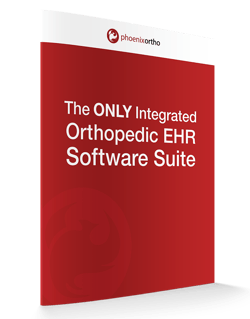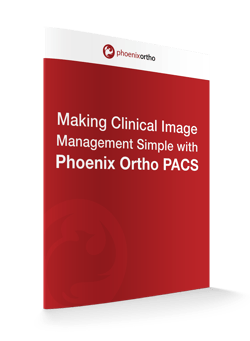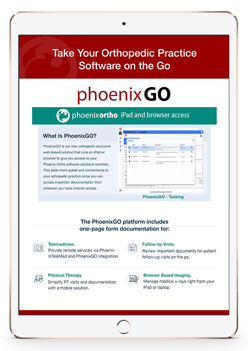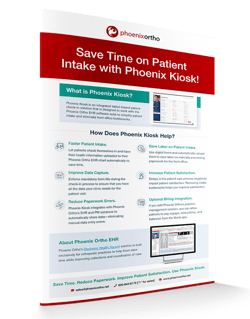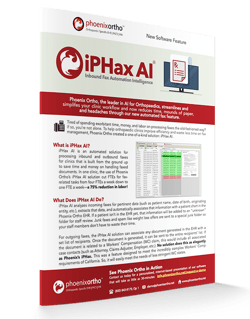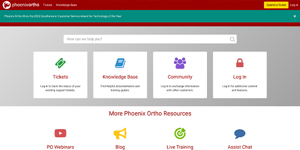Patient check in is one of the most important processes in any clinic’s workflow. However, many orthopedic clinics struggle to master their patient intake process. When patients show up, they fill out a long and complicated patient sign-in sheet—then they wait for that information to be copied and filed by the front desk staff before they can see their physician.
Why is optimizing the patient intake process important? Also, how can you optimize your patient check in process to save time and improve patient satisfaction?
Why Patient Check-In Processes Matter: Patient Satisfaction
In a busy orthopedic clinic where doctors are expected to meet with dozens of patients each day, even small delays can really add up. A delay of just two minutes can be annoying to the first patient in line—and that frustration only increases for each successive patient waiting to check in as delays continue to stack.
Delays in patient check-in processes have a direct correlation to patient satisfaction scores. However, that isn’t the only part of the patient experience negatively affected by a long wait during check-in processes. According to AJMC:
“The clinical ambulatory patient experience is heavily influenced by time spent waiting for provider care. Not only are metrics regarding the likelihood to recommend and the overall satisfaction with the experience negatively impacted by longer wait times, but increased wait times also affect perceptions of information, instructions, and the overall treatment provided by physicians and other caregivers.”
The longer patients have to wait for a clinic’s patient intake process, the more dissatisfied they will be—and the more likely it is that they’ll avoid your clinic in the future. Worse, they may even disregard critical orthopedic treatment advice.
Delays in Patient Check-In Process Can Reduce the Number of Patients You Can See
In addition to reducing patient satisfaction, delays in your patient check in process can limit your capacity. If your patient intake process takes too long, it can discourage patients from finishing the check-in—causing them to search elsewhere for care. Double or triple-booking time slots can alleviate long check-in times somewhat by having more people filling out paperwork at once. However, this can lead to other problems if the extra bookings put orthopedic physicians over their capacity.
This, in turn, reduces the clinic’s collections, as there will be fewer patients being seen each day. Having multiple patients filling out their patient sign in sheets simultaneously helps. However, if the delay is because of back office processing of paperwork, the time saved is going to be negligible.
So, how can you improve the efficiency of your patient check-in process to save time and clear bottlenecks at the front office?
Using a Patient Check in Kiosk Software to Eliminate Delays
One of the easiest ways to eliminate bottlenecks during patient check in is to use a patient management software to help automate key data capture and filing processes. For example, Phoenix Ortho’s patient check in software solution, Phoenix Kiosk, captures key demographic, medical history, and financial data.
It also allows patients to sign/complete consent and other smart forms (pain chart, Harris Hip Score, etc.) while also making payments (co-pays, deductibles, etc.) using a touch screen tablet. The process is managed and expedited by intake staff who simply monitor Phoenix Ortho’s unique Kiosk dashboard and are alerted to any patients who exceed expected time limits in doing so.
Once captured, the check in software uploads the data to the patient’s chart in the Phoenix Ortho Electronic Health Record (EHR) software, where the physician seeing the patient can access it immediately. This easy sharing of data is possible because the Phoenix Ortho Kiosk was purpose-built for the EHR and is fully integrated instead of being a third-party interface.
Using Phoenix Kiosk to manage patient check-in skips a lot of manual paper shuffling, virtually eliminating wait times for traditional paperwork processing tasks. Additionally, holding patient records in an EHR helps to minimize risk of missing patient health history data, since previously-entered data from past visits will be recorded in the EHR database.
Benefits of Using a Patient Portal to Streamline the Check-In Process
By using an electronic patient check in kiosk solution, orthopedic clinics can dramatically reduce patient wait times caused by excessive paperwork tasks. This helps to:
- Increase Patient Satisfaction. Lower wait times = Happier patients!
- Improve Patient Intake for the Clinic. By saving time on paperwork, more patients can be processed each day.
- Collect More at the Point of Care. By having patients process payment data in Phoenix Kiosk, collections can be made at point of care rather than having to wait for later invoices.
- Avoid Clunky Third-Party Interfaces. Phoenix Kiosk was custom-built as an integrated component of the Phoenix Ortho EHR software—ensuring ease of operation while eliminating the IT issues common to interfacing software from different vendors.
If you’re ready to improve patient satisfaction and build your orthopedic clinic’s success, reach out to the Phoenix Ortho team today!
Schedule a 1:1
Get in touch with Phoenix Ortho to learn more about how you can save time, money, and mouse clicks with an orthopedic-specific EHR.





